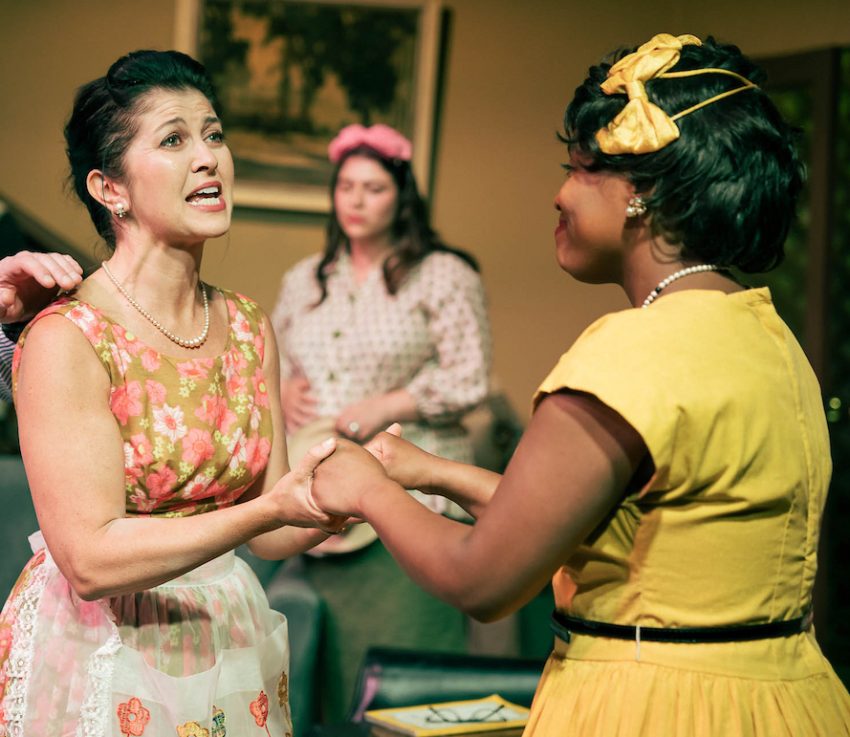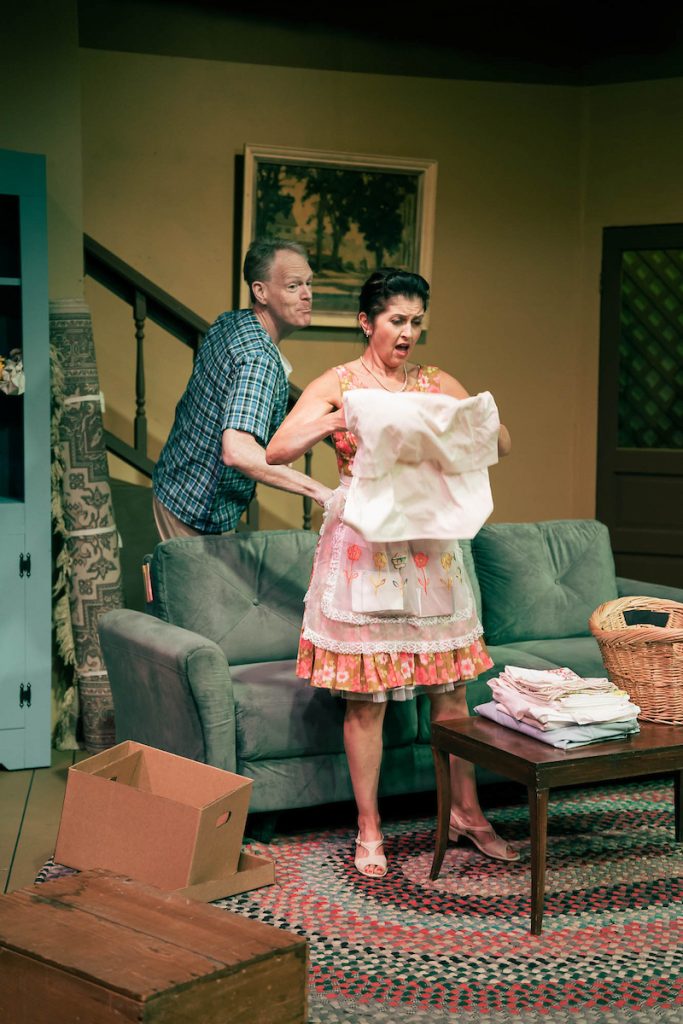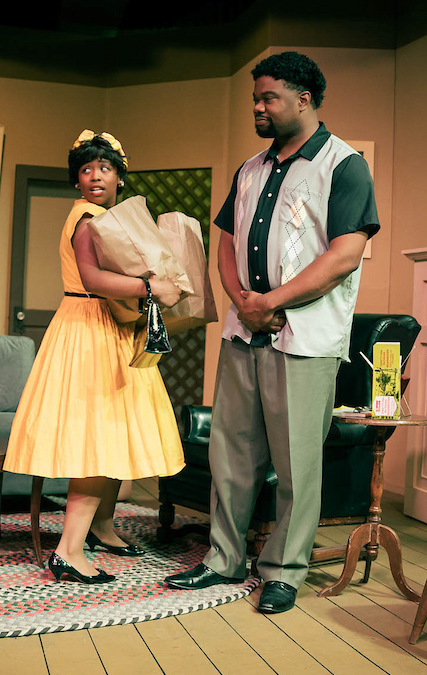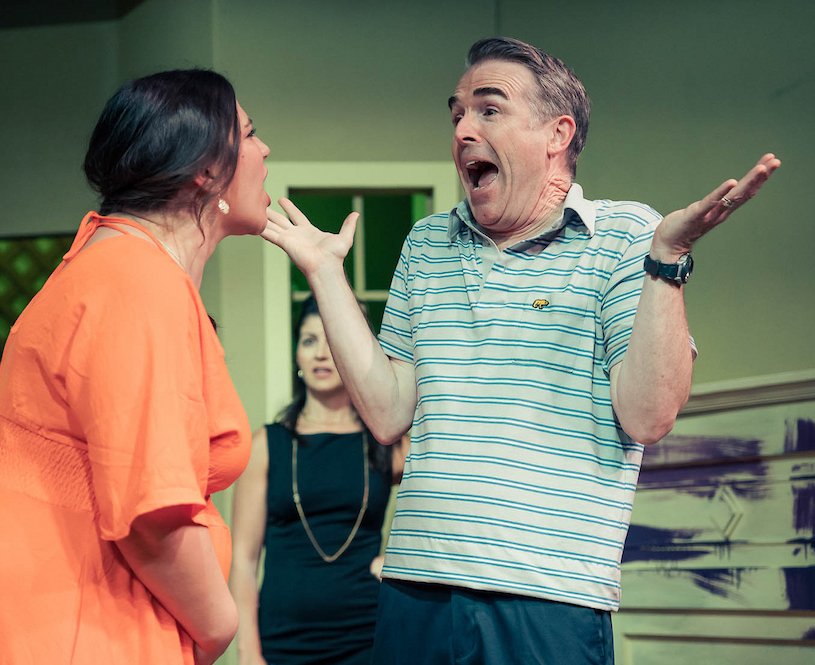
“Clybourne Park”: A Powerful Production of Pulitzer Prize Masterpiece—at Masquers
Bruce Norris Updates “A Raisin in the Sun” with Wit & Wisdom
by Lynne Stevens
Using Lorraine Hansberry’s classic 1959 play about racial prejudice in Chicago as inspiration, Bruce Norris crafts a tight blend of comedy and drama to shine a spotlight on the continuing struggles between the races.
Masquers Playhouse production, skillfully directed by Richard Perez, is as good as any you will see on Broadway. The cast is fabulous, the play audacious. So pertinent, it’s not to be missed!
1959: “There Goes the Neighborhood”
Incredible timing makes “Clybourne Park” a standout.
Bev (perky Allison Gamlen) and Russ (volatile Evan Mooney), a middle-aged white couple, are packing to move out of their Chicago home after 30 years. We’re tittering at the ridiculous comments between them as they discuss the derivation of the name Neapolitan. The actors seem to be searching for meaning by learning the root of words.

When Bev and Russ sell their house to an African American family, smarmy Karl (excellent Steve Rhyne), representing the racist community association, arrives to kill the deal. Oblivious to the presence of the Black maid, Francine (wonderful Brianna Franklin), Karl goes into a racist rant.
Continuing with Hansberry’s exposé of racial segregation, the neighborhood has been overtaken by white gentrifiers. But they are fighting Black home ownership—again!
2009: “Race & Gentrification”
Fifty years on, the original house is plagued with graffiti, disrepair, and neglect. Lena (Franklin again) is one of several upwardly mobile 30-somethings going over proposals for the development of the house. Like Karl in 1959, she argues that white newcomers will erase the cultural significance of the area.
Time and again we are faced with the question “Can’t we all get along?” Can different races live side by side and share cultures, food, and experiences? “Clybourne Park” shows us how hard it is to evolve.

A young white couple, Lindsey (provocative Natalie Tichenor) and Steve (versatile Steve Rhyne again), want to move into the now African American neighborhood. They want to alter the height of the same home we saw at the start of the play. They are direct and used to getting their way.
In fast-paced dialogue, the gentrifiers try to outdo each other with their displays of “sophistication.” These privileged and competitive show-offs, challenge each other to name the capitals of countries they have visited.
Discussion about the house becomes more and more heated. It takes a little history lesson from Lena, who lived in the house years ago, to calm down the group.
Speaking about her great aunt, Francine, the maid of 1959, Lena argues:
LENA. But, given the make-up of the neighborhood at that time and the price of a home like this one, the question naturally arises as to whether it was the thing that happened here in the house – whether that in some way –
KEVIN. Played a factor.
LENA. – in making a place like this affordable. For a person of her income.
This sly commentary of Lena’s dashes Lindsey and Steve’s interest in the house, helping to retain the character of the neighborhood. They didn’t have a ghost of a chance of succeeding. The history of the house saved it. For now.
The more things change, the more they stay the same. Take a look around your neighborhood and talk to the older members of the community. Gentrification and urban renewal have destroyed communities in the Bay Area.
I highly recommend “Clybourne Park” for a gripping trip through history.

“Clybourne Park” by Bruce Norris, directed by Richard Perez, set design by John Hull, costume design by Hope Birdwell, lighting by Paul Seliga, at Masquers Playhouse, Point. Richmond, California. Info: masquers.org – to July 21, 2024.
Cast: Brianna Franklin, Allison Gamlen, Evan Mooney, Benjamin Pierson, Steve Rhyne, Joshua Roberts, and Natalie Tichenor.
Banner photo: Allison Gamlin, Natalie Tichenor, & Brianna Franklin. Photos: Mike Padua